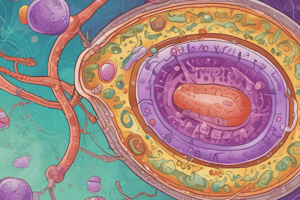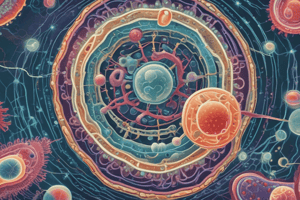Podcast
Questions and Answers
What is the function of cytoplasm?
What is the function of cytoplasm?
- Provides structural support
- Filling the entire cell (correct)
- Used for DNA storage
- Controls the flow of materials in and out of the cell
What are ribosomes composed of?
What are ribosomes composed of?
Protein and RNA
What is the nucleoid composed of?
What is the nucleoid composed of?
Condensed DNA molecules
What surrounds the cytoplasm in bacterial cells?
What surrounds the cytoplasm in bacterial cells?
What is the S Layer used for?
What is the S Layer used for?
What function do fimbrae serve?
What function do fimbrae serve?
What does the outer membrane contain that is toxic to mammals?
What does the outer membrane contain that is toxic to mammals?
What provides structural support and shape for bacterial cells?
What provides structural support and shape for bacterial cells?
What contributes to the shape of a bacterial cell?
What contributes to the shape of a bacterial cell?
What is the function of a pilus?
What is the function of a pilus?
What serves protective, adhesive, and receptor functions in bacteria?
What serves protective, adhesive, and receptor functions in bacteria?
What are stored nutrients in bacteria called?
What are stored nutrients in bacteria called?
What is the purpose of bacterial microcompartments?
What is the purpose of bacterial microcompartments?
What is a plasmid?
What is a plasmid?
What is the function of flagella?
What is the function of flagella?
What is an endospore?
What is an endospore?
Flashcards are hidden until you start studying
Study Notes
Bacterial Cell Structure
-
Cytoplasm: A water-based solution that fills the entire cell, providing a medium for biochemical reactions.
-
Ribosomes: Tiny RNA-protein complexes that function as sites for protein synthesis, crucial for cell functionality.
-
Nucleoid: Region containing condensed DNA molecules, organizing genetic material essential for reproduction and cellular operations.
-
Cell Membrane: A lipid-protein bilayer that surrounds the cytoplasm, controlling the flow of materials in and out of the cell, thus maintaining homeostasis.
-
S Layer: A protective monolayer of protein that enhances cell attachment to surfaces and offers an additional layer of defense.
-
Fimbrae: Hair-like bristles on the cell surface that facilitate adhesion to other cells and surfaces, promoting colonization.
-
Outer Membrane: An additional lipid membrane akin to the cytoplasmic membrane, embedding lipopolysaccharides that can be toxic to mammals when released.
-
Cell Wall: A semirigid structure providing shape and structural support to the cell, essential for maintaining integrity against osmotic pressure.
-
Cytoskeleton: Composed of long protein fibers that reinforce the cell's shape and assist in cellular movements.
-
Pilus: Appendage that enables the transfer of DNA between bacteria during conjugation, facilitating genetic exchange.
-
Glycocalyx: Protective, adhesive coating outside the cell wall, serving vital roles in protecting against desiccation and aiding in attachment.
-
Inclusion/Granule: Storage structures for nutrients like fat, phosphate, or glycogen, these are accessible during nutrient scarcity.
-
Bacterial Microcompartment: Protein-coated structures that organize enzymes and proteins within the cytoplasm for efficient metabolic processes.
-
Plasmid: Circular, double-stranded DNA containing extra genetic information that can confer advantages, such as antibiotic resistance.
-
Flagella: Specialized appendages that consist of a long, rotating filament, helping in locomotion by propelling the cell forward.
-
Endospore: A resilient, dormant structure formed by certain bacteria to withstand harsh environmental conditions, ensuring survival.
Studying That Suits You
Use AI to generate personalized quizzes and flashcards to suit your learning preferences.




